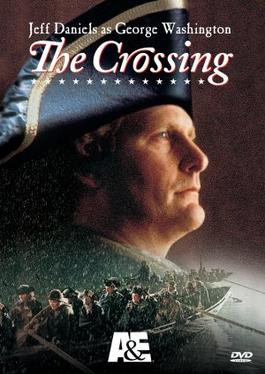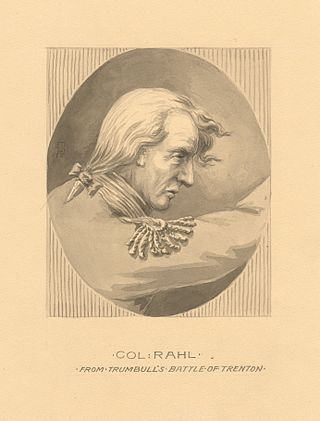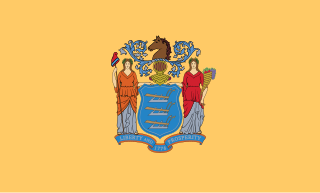| |||||
| Decades: | |||||
|---|---|---|---|---|---|
| See also: | |||||
| 1776 in the United States |
| 1776 in U.S. states |
|---|
| States |
| List of years in the United States by state or territory |
This is a list of events in the year 1776 in New Jersey.
| |||||
| Decades: | |||||
|---|---|---|---|---|---|
| See also: | |||||
| 1776 in the United States |
| 1776 in U.S. states |
|---|
| States |
| List of years in the United States by state or territory |
This is a list of events in the year 1776 in New Jersey.

The Battle of Trenton was a small but pivotal American Revolutionary War battle on the morning of December 26, 1776, in Trenton, New Jersey. After General George Washington's crossing of the Delaware River north of Trenton the previous night, Washington led the main body of the Continental Army against Hessian auxiliaries garrisoned at Trenton. After a brief battle, almost two-thirds of the Hessian force were captured, with negligible losses to the Americans. The battle significantly boosted the Continental Army's waning morale, and inspired re-enlistments.

Count Carl Emil Ulrich von Donop was a Hessian colonel who fought in the American Revolutionary War. He died of wounds during the Battle of Red Bank.

The New York and New Jersey campaign in 1776 and the winter months of 1777 was a series of American Revolutionary War battles for control of the Port of New York and the state of New Jersey, fought between British forces under General Sir William Howe and the Continental Army under General George Washington. Howe was successful in driving Washington out of New York, but overextended his reach into New Jersey, and ended the New York and New Jersey campaign in January 1777 with only a few outposts near New York City under British control. The British held New York Harbor for the rest of the Revolutionary War, using it as a base for expeditions against other targets.

The Crossing is a 2000 American television historical drama film about George Washington's crossing of the Delaware River and the Battle of Trenton. Directed by Robert Harmon and adapted by Howard Fast from his novel of the same name, the film stars Jeff Daniels as George Washington. Also appearing are Roger Rees as Hugh Mercer, Sebastian Roché as John Glover, and Steven McCarthy as Alexander Hamilton. The film premiered on A&E on January 10, 2000.

George Washington's crossing of the Delaware River, which occurred on the night of December 25–26, 1776 during the American Revolutionary War, was the first move in a complex and surprise military maneuver and attack organized by George Washington, the commander-in-chief of the Continental Army, which culminated in their attack on Hessian forces garrisoned at Trenton. The Hessians were German mercenaries hired by the British.

Johann Gottlieb Rall was a German colonel best known for his command of Hessian troops at the Battle of Trenton during the American Revolutionary War.

The Battle of the Assunpink Creek, also known as the Second Battle of Trenton, was a battle between American and British troops that took place in and around Trenton, New Jersey, on January 2, 1777, during the American Revolutionary War, and resulted in an American victory.

New Jersey played a central role in the American Revolution both politically and militarily. It was the site of more than 90 military engagements, including the pivotal battles of Trenton, Princeton, and Monmouth. George Washington led his army across the state four times and encamped there during three hard winters, enduring some of the greatest's setbacks of the war as well as seminal victories. New Jersey's decisive role in the conflict earned it the title, "Crossroads of the American Revolution".

The Ambush of Geary, also known as the Amwell Skirmish, was a skirmish of the American Revolutionary War fought on 14 December 1776 in Amwell Township of Hunterdon County, New Jersey. Cornet Francis Geary, the leader of a company of dragoons, was shot in an ambush set up by local militiamen led by Captain John Schenck.
James Linn was an American lawyer, politician and Revolutionary War veteran who served as a United States representative from New Jersey, serving one term from 1799 to 1801.

1776 (MDCCLXXVI) was a leap year starting on Monday of the Gregorian calendar and a leap year starting on Friday of the Julian calendar, the 1776th year of the Common Era (CE) and Anno Domini (AD) designations, the 776th year of the 2nd millennium, the 76th year of the 18th century, and the 7th year of the 1770s decade. As of the start of 1776, the Gregorian calendar was 11 days ahead of the Julian calendar, which remained in localized use until 1923.
Events from the year 1776 in Great Britain.

The Battle of Iron Works Hill, also known as the Battle of Mount Holly, was a series of minor skirmishes that took place on December 22 and 23, 1776, during the American Revolutionary War. The fighting took place in Mount Holly, New Jersey, between an American force mostly composed of colonial militia under Colonel Samuel Griffin and a force of 2,000 Hessians and British regulars under Carl von Donop.
The Provincial Congress of New Jersey was a transitional governing body of the Province of New Jersey in the early part of the American Revolution. It first met in 1775 with representatives from all New Jersey's then-thirteen counties, to supersede the Royal Governor. In June 1776, this congress had authorized the preparation of a constitution, which was written within five days, adopted by the Provincial Congress, and accepted by the Continental Congress.

The Battle of Trenton was fought on December 26, 1776, during the American Revolutionary War campaign for New Jersey. In a surprise attack, the Continental Army led by George Washington attacked the winter quarters of a brigade composed primarily of German troops from Hesse-Kassel in Trenton, New Jersey. The Hessian brigade was under the command of Colonel Johann Rall; he died of wounds sustained in the battle, and about two thirds of his men were taken prisoner. It was the first major victory after a long string of defeats that had resulted in the loss of New York City, and was a significant boost to American morale. It was followed by two more American victories, first in a second battle at Trenton on January 2, 1777, and then on January 3 at Princeton.
1776 is celebrated in the United States as the official beginning of the nation, with the Declaration of Independence of the Thirteen Colonies from the British Empire issued on July 4.
John Mott was a captain in the 1st Hunterdon Regiment of the New Jersey militia during the American Revolutionary War. He served as a guide to General George Washington and the Continental Army during their march down along the Delaware River prior to the Battle of Trenton.
Nicholas Haussegger was a native of Bern, Switzerland who arrived in the British Colonies in North America about 1744 as a subaltern officer in the British army during the French and Indian War. After the war he purchased a farm in Lebanon county and became a leader in the local Pennsylvania German community. At the beginning of the American Revolutionary War Haussegger joined the 4th Pennsylvania Battalion as a field officer. He was placed in command of the German Battalion, a unit of ethnic Germans from Pennsylvania and Maryland, on July 17, 1776. He led his battalion at Trenton in late December 1776. A week later, he was taken prisoner at Assunpink Creek and investigated over allegations of desertion and attempting to persuade American prisoners-of-war to join the British army. Evidence credible enough to bring him to trial apparently never materialized, but he felt "neglected and injuriously treated" by the incident and eventually resigned his commission in 1781. He is believed to have died at his farm in Pennsylvania in 1786, however there were also contemporaneous claims made that he went to Canada with his wife.

The Capture of the Hessians at Trenton, December 26, 1776 is the title of an oil painting by the American artist John Trumbull depicting the capture of the Hessian soldiers at the Battle of Trenton on the morning of Thursday, December 26, 1776, during the American Revolutionary War. The focus is on General George Washington aiding the mortally wounded Hessian Colonel Johann Gottlieb Rall. Nearly 900 Hessians were captured at the battle. It is one of Trumbull's series of historical paintings on the war, which also includes the Declaration of Independence and The Death of General Mercer at the Battle of Princeton, January 3, 1777. The painting is on view at the Yale University Art Gallery in New Haven, Connecticut.

Abraham Hunt (1741–1821) was a wealthy American merchant and farmer in Trenton, New Jersey, first Postmaster of Trenton, and served in the American Revolutionary War as a Lieutenant Colonel in the Hunterton County militia. He was a prominent member of the First Presbyterian Church in Trenton. Early in the revolution he was a member of the Provincial Congress that held some of its sessions in Trenton. He played the host and placated the German Hessian commander Johann Rall before the Battle of Trenton. Suspected of duplicity for his accommodation to the Hessians, Hunt was charged with treason, but was acquitted and went on to serve in the cause for American independence. After the war, Hunt became involved in the politics and business interests of Trenton and New Jersey overall.
The Hessian Commander, Colonel Johann Gottlieb Rall, was mortally wounded and eventually died here on December 27, 1776.